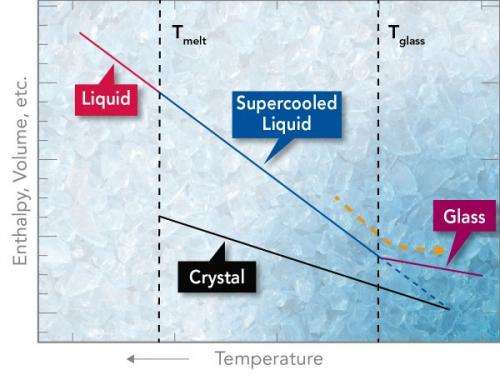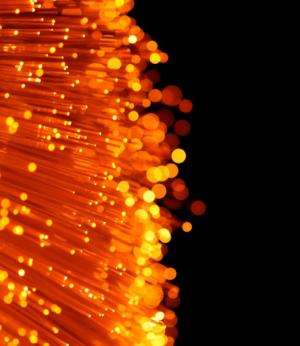By supercooling liquids, scientists can determine the physics happening in glasses

(Phys.org) -- The whereabouts of exceedingly slow-moving molecules in glasses can be quickly and efficiently measured, thanks to a new technique that uses vapor and extreme cold to drop the molecules' speed a trillion times. Designed by Dr. Scott Smith and Dr. Bruce Kay at Pacific Northwest National Laboratory, the method supercools vapor molecules turning them into a glassy film. Then, they heat the film just enough to get the molecules moving at the desired speed to study. An overview of this new method appears in an invited Perspective article in Journal of Physical Chemistry Letters.
While glass is ubiquitous in the world today, from fiber optic cables to fuel cells to pharmaceuticals, and even nuclear waste storage, fundamental glass properties are not clearly understood. Knowledge gaps exist, in part, because supercooling alcohols, water and other small molecular liquids was not easy. This difficulty meant that fundamental questions were the purview of computer simulations and models. With this new technique, scientists can get precise data. The data will answer basic questions, and one day may guide transformations into key industries.
"This work is not immediately relevant to nuclear waste or pharmaceuticals. What we are trying to do is understand the elementary chemical physics that occur around the glass transition," said Kay.
To understand a supercooled liquid, it is helpful to look at how liquids change when chilled. As liquids are cooled, the molecules slow down and take up set positions. As more molecules take up set positions, the liquid solidifies or crystallizes. This is the change that happens when water freezes into ice. But, if the circumstances are just right, the liquid takes a different path. It becomes a viscous, syrupy concoction, known as a supercooled liquid. This happens because the molecules slow down, but stay disorganized. If the temperature drops a bit more, to the glass transition temperature, the supercooled liquid turns into a glass.
The challenge for years has been supercooling a liquid to low temperatures without getting the crystal form.

The new PNNL technique turns that problem around by starting with the gaseous form of the sample. The scientists deposit the vapor onto a super cold surface, creating a nanometer-deep glass. The glass film is then heated slightly to create a supercooled liquid. Before the liquid molecules can rearrange themselves into crystals, the scientists can apply different analytical techniques.
"The trouble with cooling from the liquid phase is that the samples crystallize too early in the process for studying," said Smith. "This new method may be a way to learn something about liquids and test theoretical ideas and models."
Smith and Kay have been working with supercooled liquids for more than a decade. In 2009, they devised a method that placed a layer of krypton atoms under the sample liquid at low temperatures. Then, they applied heat that caused the sample molecules to start moving and allowed the krypton atoms to bubble through. Using a mass spectrometer, they measured when the krypton atoms reached the material's surface. These data are used to calculate diffusion rates for different supercooled liquid materials.
Smith and Kay are focusing on using the vapor deposition approach to determine the properties of super cold mixes. "We want to study mixtures of alcohol and water; nobody has been able to measure this before," said Kay.
More information: RS Smith and BD Kay. 2012. "Breaking Through the Glass Ceiling: Recent Experimental Approaches to Probe the Properties of Supercooled Liquids near the Glass Transition." The Journal of Physical Chemistry Letters 3(6):725-730. DOI: 10.1021/jz201710z
Journal information: Journal of Physical Chemistry Letters
Provided by Pacific Northwest National Laboratory




















